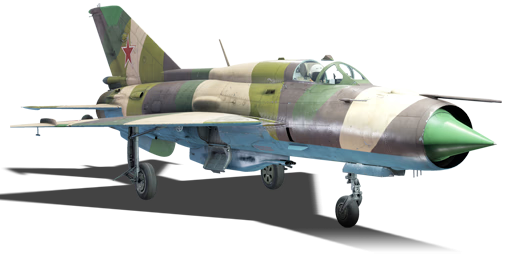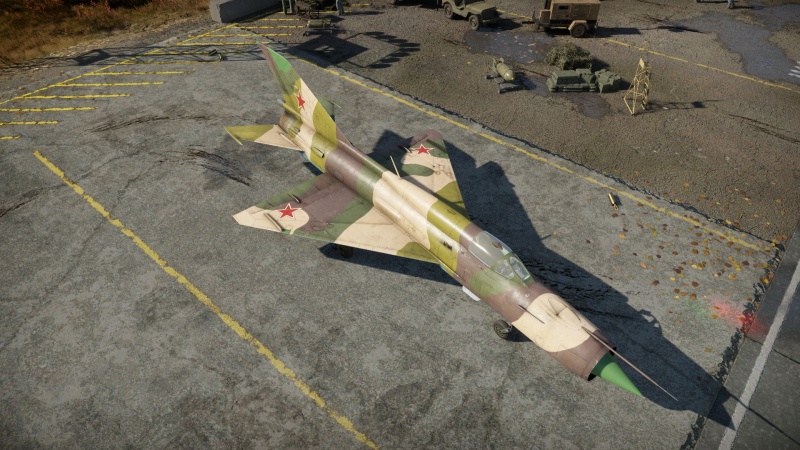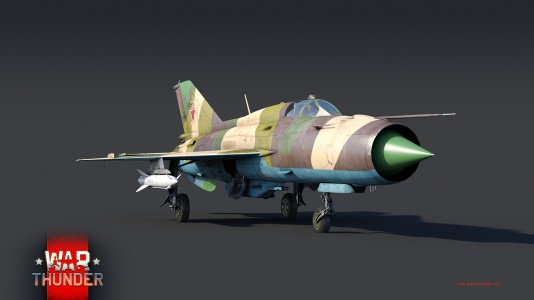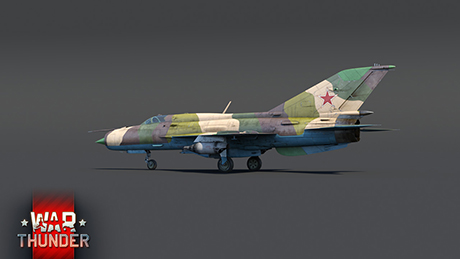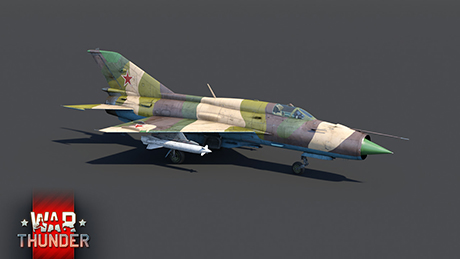Difference between revisions of "MiG-21PFM"
(→History) |
TankerDman (talk | contribs) m (→Pros and cons: From my experience with the pfm in sim) (Tag: Visual edit) |
||
| Line 127: | Line 127: | ||
* Low amount of ammunition | * Low amount of ammunition | ||
* No flares or RWR | * No flares or RWR | ||
| + | * poor cockpit visibility (sb) | ||
| + | * no gun ballistic radar (rb/sb) | ||
== History == | == History == | ||
Revision as of 03:01, 10 January 2021
| This page is about the Russian jet fighter MiG-21PFM. For other versions, see MiG-21 (Family). |
Contents
Description
The MiG-21PFM is a gift rank VI Soviet jet fighter with a battle rating of 8.7 (AB), 9.3 (RB), and 10.0 (SB). It was introduced during Update "Hot Tracks" as a reward for the 2020 Operation W.I.N.T.E.R. event.
General info
Flight performance
Describe how the aircraft behaves in the air. Speed, manoeuvrability, acceleration and allowable loads - these are the most important characteristics of the vehicle.
| Characteristics | Max Speed (km/h at 13,000 m) |
Max altitude (metres) |
Turn time (seconds) |
Rate of climb (metres/second) |
Take-off run (metres) | |||
|---|---|---|---|---|---|---|---|---|
| AB | RB | AB | RB | AB | RB | |||
| Stock | 2,211 | 2,196 | 16000 | 37.6 | 38.1 | 123.2 | 115.9 | 750 |
| Upgraded | ___ | ___ | __._ | __._ | __._ | __._ | ||
Details
| Features | |||||
|---|---|---|---|---|---|
| Combat flaps | Take-off flaps | Landing flaps | Air brakes | Arrestor gear | Drogue chute |
| X | ✓ | ✓ | ✓ | X | ✓ |
| Limits | ||||||
|---|---|---|---|---|---|---|
| Wings (km/h) | Gear (km/h) | Flaps (km/h) | Max Static G | |||
| Combat | Take-off | Landing | + | - | ||
| 1365 | 700 | N/A | 550 | 450 | ~11 | ~5 |
| Optimal velocities (km/h) | |||
|---|---|---|---|
| Ailerons | Rudder | Elevators | Radiator |
| < 650 | < 600 | < 900 | N/A |
Survivability and armour
Examine the survivability of the aircraft. Note how vulnerable the structure is and how secure the pilot is, whether the fuel tanks are armoured, etc. Describe the armour, if there is any, and also mention the vulnerability of other critical aircraft systems.
Modifications and economy
Armaments
Offensive armament
The MiG-21PFM is armed with:
- 1 x 23 mm GSh-23L cannon, belly-mounted (200 rpg)
Suspended armament
The MiG-21PFM can be outfitted with the following ordnance:
- Without load
- 32 x S-5K rockets
- 64 x S-5K rockets
- 2 x S-24 rockets
- 2 x R-3S missiles
- 2 x Kh-66 missiles
- 2 x 500 kg FAB-500M-54 bombs (1,000 kg total)
- 2 x 250 kg OFAB-250sv bombs (500 kg total)
Usage in battles
Describe the tactics of playing in the aircraft, the features of using aircraft in a team and advice on tactics. Refrain from creating a "guide" - do not impose a single point of view, but instead, give the reader food for thought. Examine the most dangerous enemies and give recommendations on fighting them. If necessary, note the specifics of the game in different modes (AB, RB, SB).
Pros and cons
Pros:
- Mouse-guided Kh-66 missiles allowing for long distance air-to-ground engagements
- AA radar
- Good manoeuvrability at high speeds
Cons:
- Only 2 pylons for suspended weapons
- Bleeds lots of energy in sharp turns due to its delta wing design
- Low amount of ammunition
- No flares or RWR
- poor cockpit visibility (sb)
- no gun ballistic radar (rb/sb)
History
Described as the "AK of airplanes", the MiG-21 is a robust, reliable, and easy to maintain jet fighter developed during the second generation of jet fighters that has since the 1950s earned a strong place in air forces of the Soviet Union as well as foreign operators such as North Korea, India, and Croatia. With many variants, the aircraft has had many life extensions over this 60+ year period of operation, with some aircraft in air forces having been in service for more than 30 years.
The story begins in 1953, when the Soviet government issued a requirement for a lightweight aircraft capable of Mach 2 for its Frontal Air division of the Soviet Air Force. Having had experience in the field of swept-wing, fast jet fighters Mikoyan-Gurevich felt confidently about their ability to produce such an aircraft. An aircraft such as the MiG-21 was only able to come to fruition after multiple test models and research with various prototypes. Beginning with the Ye-1 the Mikulin AM-11 turbojet was fitted, which in turn created another model called the Ye-50. This second one-off prototype was essentially a Ye-1 with the addition of the AM-9Ye turbojet in place of the AM-11, as well as adding liquid-fuelled rocket boosters for added thrust. After the initial prototypes, the Ye-2 was designed with the idea of using the original AM-11 turbojet, but was left waiting and soon opted to use the AM-9B found on the existing MiG-19 "Farmer" series of aircraft also produced by Mikoyan-Gurevich. This third aircraft was leads ahead of the previous models, having had development so far along that on February 14th, 1955 it took to the skies for the first time. This aircraft had good results, but was also slow as well leaving much to be built upon. With this, a similar aircraft called the Ye-4 was built and flown on June 16th that same year. This aircraft had many design implementations found on the final MiG design, such as the small-area delta wings and conventional tailplane. However, this prototype wouldn't be much of an improvement over the previous prototypes, only proving marginally better in terms of performance. With the first flight of both the Ye-5 and Ye-501 prototypes occurring on January 9th, 1956, Mikoyan-Gurevich was confident production would begin soon and issued two company designations for each model. These being MiG-21 for the delta-wing modification as well as MiG-23 for the swept-wing design, the latter not to be confused with the swing-wing supersonic aircraft also built by MiG.
The western world would finally get a peek at this development on June 24th, 1956 when variants of each design flew over during the Aviation Day celebration at the Moscow Tushino airfield. Taking notice of this, NATO and western observers would quickly take note, leading to NATO giving the codenames "Faceplate" and "Fishbed" to the swept and delta wing designs respectively. Development didn't end there however, as more prototypes were built and flown. Three Ye-6 aircraft were soon seen wearing the tailed-delta wing design seen on the previous Ye-5 but featuring clipped wingtips as well as a redesigned nose cone. With flight testing underway by May 20th, 1958, it was soon brought to a halt when the Ye-6/1 prototype lost its engine during a test flight. An effort was made by the test pilot to get it restarted but was in vain as the aircraft was lost, with the test pilot following shortly after injuries sustaining from the accident. However, with these setbacks testing and development would soon turn into production as the aircraft soon succeeded the requirement set by the Soviet government, hitting a speed of Mach 2.05. Production forms followed, and the western world would get a look in 1961 during a public appearance at the final production version of the MiG-21. The MiG-21 served continuously in the Soviet Air Force, and later the Russian Air Force, for many years following its introduction, orders and deliveries having been placed in 1957 that continued into the next year. While in service, the aircraft would first get the designation MiG-21F in 1959, and the aircraft would have a fruitful career with Russia as well as many foreign operators.
One notable example of the MiG-21, built off of the PFS airframe, was the PFM. This aircraft featured many improvements and reductions from the existing airframe. While retaining its ability for unpaved field operations this design featured the removal of the internal mounted gun under the nose. This variant also featured the addition of an inflated fuselage section behind the new split canopy design allowing for more space for electronics as well as fuel tanks within the fuselage. Stated before, it was designed without and internal gun forcing the aircraft to rely on suspended armaments such as missiles, rockets such as the RP-21M, and a belly-mounted GP-9 gun pod. Seeing production for the Soviet Air Force in Gorki from 1964 to 1965 and foreign production and export in Moscow from 1966 to 1968, the MiG-21PFM saw great success with foreign operators, seeing extended use throughout the years with air forces such as Poland, India, and Egypt in addition to the Soviet Union.
Devblog
During the modernization of the second generation of MiG-21 fighters, the Soviet military authorities demanded the design team to modify the aircraft for takeoff and landing from unpaved airfields. As a solution, the engineers proposed equipping the aircraft with a system for blowing the boundary layer from the flaps, and the Tumansky and Metskhvarishvili design bureau began developing a version of the R11F-300 engine with an air stream from the compressor. The boundary layer blowing system significantly improved the take-off and landing characteristics of the aircraft, the takeoff and run lengths were reduced, and the landing speed drastically reduced. Along with other modifications and improvements, the serial modification of the MiG-21 with the boundary layer blowing system began to be produced under the MiG-21 PFS index, later upgraded to the MiG-21 PFM version. Aircraft of this modification were produced in fairly large numbers since 1964, both for domestic use and export. The MiG-21 PFM served in Vietnam and Afghanistan.
Media
- MiG-21 PFM Devblog Images
See also
Links to the articles on the War Thunder Wiki that you think will be useful for the reader, for example:
- reference to the series of the aircraft;
- links to approximate analogues of other nations and research trees.
External links
- [Devblog] MiG-21 PFM
- Military Factory - Mikoyan-Gurevich MiG-21 "Fishbed": website
- Stephan Wilkinson - The Iconic MiG-21 "Fishbed": website
| USSR jet aircraft | |
|---|---|
| Bereznyak-Isayev | BI |
| Yakovlev | Yak-15 · Yak-15P · Yak-17 · Yak-23 · Yak-28B · Yak-30D · Yak-38 · Yak-38M · Yak-141 |
| Mikoyan-Gurevich | MiG-9 · MiG-9 (l) · MiG-15 · MiG-15bis · MiG-15bis ISh · MiG-17 · MiG-17AS · MiG-19PT |
| MiG-21F-13 · MiG-21PFM · MiG-21S (R-13-300) · MiG-21SMT · MiG-21bis | |
| MiG-23M · MiG-23ML · MiG-23MLD · MiG-27M · MiG-27K | |
| MiG-29 · MiG-29SMT | |
| Lavochkin | La-174 · La-15 · La-200 |
| Sukhoi | Su-9 · Su-11 |
| Su-7B · Su-7BKL · Su-7BMK · Su-17M2 · Su-17M4 · Su-22M3 | |
| Su-24M | |
| Su-25 · Su-25BM · Su-25K · Su-25T · Su-25SM3 · Su-39 | |
| Su-27 · Su-27SM | |
| Su-34 | |
| Ilyushin | IL-28 · IL-28Sh |
| Tupolev | Tu-14T |


